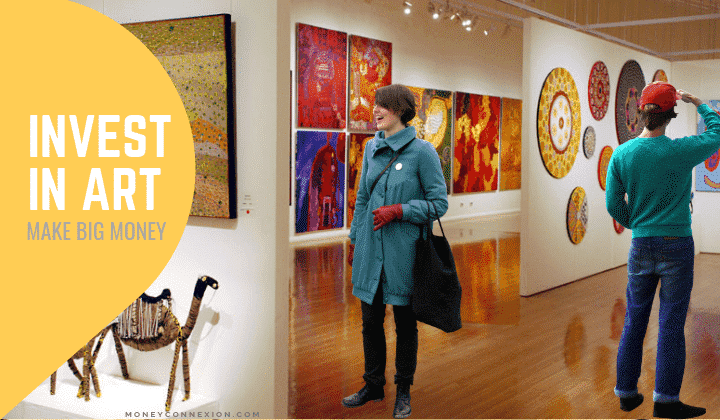Buying rare, unique collectible paintings and photographs has become another form of keeping money invested for a while. Now you must be wondering how art can be an investment portfolio. Here I present a step by step guide on how to invest in artwork.
For most Americans, the traditional way of investment portfolio use to consists of money stashed away in savings schemes, stocks, bonds, retirement and pension plans. Others include valuables such as pricey jewellery to their portfolio.
In recent years, a top investment avenue that is emerging in the US is art. Unique paintings and photographs grow in monetary value and can be sold at auctions in the US or abroad. We are not talking of Van Gogh and Da Vinci here, as I will explain later.
Investing in Art

Investing in art is not easy. Nor is it inexpensive. With some effort and little more investment, you can make a lot of money by collecting and selling art.
In fact, many people worldwide now include art as an investment in their retirement portfolio. If this sounds interesting, read on. I will explain how to add art to your investment portfolio.
Explore Great Art
There are two ways to find fine art paintings and photographs-for your investment portfolio. Understandably, this require some effort on your part.
Start by exploring around at galleries and exhibitions held by art colleges in your city. You will come across a few each year. There are some you may like and others that may not hold as much appeal.
Once a painting catches your eye, the next thing is how to find the value of artwork. You need to find credentials of the artist. Generally, upcoming or budding artists will have the best pieces.
By credentials, I mean find whether the artist has participated in previous exhibitions, sold art pieces and prices commanded by these paintings. This should give a clear idea about popularity of an artist.
So looking for an artist with a credible track record should not be tough. There will definitely be instances where you do not like a painting. Yet, if the artist has some credentials and has sold to collectors and investors in the past, you could consider buying one.
It is not necessary to display such paintings on walls: you can keep them safe in special containers that comes with the purchase.
The second way to buy art is at auctions held by art schools, brick-and-mortar as well as online galleries. While auctions can prove a bit pricey, especially when your pockets are not as deep.
Monetary value of every painting sold at brick-and-mortar or online auctions is bound to increase exponentially over the years.
They go under the hammer because an investor or collector needs the money urgently. Buying a painting at auctions is the surest way to know your investment will fetch good returns at later date.
I suggest you first understand how the entire cycle of buying and selling art works by visiting exhibitions and auctions before venturing to make any investments.
Search Your Pockets
Undoubtedly, you would have heard of art including paintings, drawings, photographs and sculpture selling at millions of Dollars. True.
But these are masterpieces created by legendary artists such as Picasso and Michelangelo. Here we are talking of buying art from emerging artists who would willingly sell their art for prices between $5,000 and $10,000 or more if their works are already in demand.
Refer: 10 Most Expensive Paintings
Before venturing to invest in art, explore your pockets. Decide how much money are you realistically willing to invest in art. This should not prove difficult since we all have financial goals.
Study trends in the current art market by visiting auctions, and participating in talks hosted by art clubs. You can also get rough estimate of how much money is needed by joining online forums and social media pages hosted by art collectors.
Remember, they too were beginners in investing on art and can provide some valuable advice.When you draw a budget for investing in art, never look at returns.
If lucky, value of a painting or sculpture you bought from an art school exhibition for a few thousand Dollars can increase exponentially to fetch you very high returns.
On the other hand, some pieces of emerging artists will not appreciate in value as you would expect, despite remaining invested for years. You do not lose the money, yet returns could be lower than expected.
It is worth remembering that art market also works like stocks markets. Prices increase when investors are wary of putting their money in conventional systems like savings schemes and stocks due to market volatility.
Similarly, they tend to drop when investors have attractive, conventional and tangible options that can give them better returns.
Remaining invested in art is science in itself. You need to stay abreast with popularity of emerging artists whose works you own. As their fame increases, value of your investment rises too.
Seek Diverse Artists
Should you wish to invest in art, collect works from diverse and emerging artists. This is somewhat similar to diversifying your conventional investments in stocks and bonds.
Not all creations of one artist will rise in value. Nor will any piece of art including paintings, drawings, rare photographs and sculptures lose over a period of years.
Buying art from diverse artists serves to hedge your investments. Prices of some creations by various artists will rise sharply while others may stagnate.
Investing in works of diverse artists means your returns will buffer your money to a great extent.
Finding diverse artists is fairly simple once you start visiting art galleries, exhibitions and auctions and join online forums. Names of some artists will crop prominently while others will get relegated to oblivion.
While it makes good sense to buy art from prominent emerging artists, also look at those who find lesser mention. You will also find a list of artists that are gaining fame through online galleries.
They could have great works but have left the field for some reason. In such cases, their art becomes rare and will increase in value. Excellent paintings and other pieces of art by artists that have faded into oblivion tend to become more popular than those active.
You need to find reasons for such artist to go dormant and period during which they were famous. A lot of excellent emerging artists abandon the field due to various reasons. You could be lucky to come across great art pieces created by such rare artists.
Value & Appraisals
Unlike stocks, bonds and other tangible investments, it is nearly impossible to get valuation of your investment in art. The best and only way to know value of art in your investment portfolio is from a professional Art Appraiser or auction house.
For a small fee, they will provide you latest valuation of art in your investment portfolio. Maintain a chart listing value of your investments in art over a period of months and years to get realistic estimates about how much you can sell them for at an auction.
If you are serious about adding art to your investment portfolio, get in touch with online galleries. They provide a host of services, from appraisals to auctions. Becoming member of these online galleries provides free access to various resources such as downloadable catalogues, guides and latest news.
Some online galleries also provide valuations of works by various artists, that can help assess how much your investment in art is worth.
Getting your investment in art appraised for its value is of prime importance. If prices of a particular piece of art is running too high, it may indicate rising popularity of an artist or investment trend.
Beating Taxation
Adding art to your investment portfolio is similar to putting money in conventional schemes: you require astute short, mid and long-term planning. There are over 100 art schools in America. They churn out several dozen emerging artists every year. Hence, there is no dearth of artists when you wish to buy art.
The US government does not exempt art from taxes. Having short, mid and long-term plans for investing in art can help cut some of these taxes on your collectibles, while selling off for money.
Look at various legitimate ways to overcome tax burden on your investment in art. One is by storing them at free ports in various parts of the US. There are several companies that offer the service.
Generally, art bought from emerging collectors will not attract much taxes. Yet, the small amount paid to Internal Revenue Service every year can cause major dents in your anticipated profits.
Inquire with the local tax office or visit IRS website about taxation on art. Some states in the US do not tax art and collectibles. If you live in a state where art is indeed taxable, consider moving it out and storing at proper facilities at locations where they are exempt from taxation.
Wrap Up
Investing in art is similar to putting your money in a bank scheme, stocks, bonds, mutual funds and retirement plans, among others. It requires some knowledge of the market and proper planning- just like you would need some knowledge of financial markets.
Thousands of people across America invest some portion of their savings in art because the market is somewhat shielded against volatility peculiar to stocks, bonds and currencies. You too can add art to your investment portfolio with some effort and understanding of the market.

He began his journey with affiliate marketing in 2004 and has since built multiple 7-figure online businesses through blogging, SEO, and automation.
With over 14 years of experience in content and more than 3 years specializing in AI automations and AI agents, Pritam now helps businesses and solopreneurs automate their operations, generate leads, and scale effortlessly using AI-powered systems.
Through his training and tutorials, he has empowered thousands to turn automation into income — making him a trusted voice in India’s growing AI and automation space.






